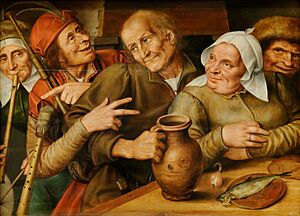Jan Matsys facts for kids
Jan Massijs (born around 1510, died 1575) was a famous painter from Flanders. He lived during the Renaissance period. Jan Massijs was known for painting many different things. He created pictures about history, everyday life (called genre scenes), and beautiful outdoor views (landscapes).
Contents
Life of Jan Massijs
Jan Massijs was born in Antwerp. His father, Quentin Matsys, was also a very important painter in Antwerp. Jan had an older brother named Cornelis Massijs, who became a painter and engraver too. Jan learned how to paint from his father.
In 1531, Jan and his brother Cornelis became masters in the Antwerp Guild of St. Luke. This was a special group for artists. Their father had died the year before. After this, people think Jan might have left Antwerp for a while. He may have worked in Fontainebleau in France. But we are not completely sure about this.
Jan was back in Antwerp by 1536. In 1538, he married his cousin, Anna van Tuylt. They had three children together.
In 1544, Jan and his brother Cornelis had to leave Antwerp. This was because of their religious beliefs. It is possible Jan went to Fontainebleau and Germany during this time. We know for sure that he spent time in Genoa, Italy.
Jan came back to Antwerp before the end of 1555. The order that made him leave was lifted. After returning, he had some disagreements with his brothers and sisters about family money.
The city council of Antwerp later asked Jan to paint several artworks. This shows he was trusted again. Sadly, these paintings were destroyed in 1576. This happened when Spanish soldiers set the city hall on fire during a time called the Spanish Fury. Jan Massijs had died the year before, in Antwerp. He was not very rich when he died.
His son, Quentin Metsys the Younger, also became a master painter in 1574. He died in Frankfurt in 1589. Jan's daughter, Susan, moved to Italy. It is thought that Jan's children left Antwerp for religious reasons, just like their father.
Jan Massijs also taught other artists. Some of his known students were Frans van Tuylt (in 1536), Frans de Witte (in 1543), and Olivier de Cuyper (in 1569).
Artistic Style and Paintings
We can see three main periods in Jan Massijs's artwork.
Early Paintings (Before 1544)
In his first period, before he had to leave Antwerp in 1544, Jan worked very much like his father. He even finished some paintings his father had left unfinished. His first painting with a date is from 1537. It is called St. Jerome in his cell. It looks just like his father's style.
Works During Exile (1544-1555)
During his time away from Antwerp, from 1544 to 1555, we know of only nine paintings by Jan. These works seem to show the influence of the School of Fontainebleau. This was a group of artists in France. It is not clear if Jan Massijs actually went to Fontainebleau or if he learned this style in other ways. While he was in Italy, he painted a picture of Andrea Doria. This is one of the few times he painted portraits of people. Only two paintings from this time have his signature and a date, both from 1552.
Later Works (After 1555)
After Jan returned to Antwerp, his art became even better. He created his own special style. He also started painting certain subjects that became well-known in his work. The people in his paintings often looked very lively and expressive.
Jan Massijs is seen as one of the first artists in the Netherlands to paint certain everyday subjects. These include 'unequal love', which showed couples with a big age difference. He also painted 'merry companies', which were scenes of people having fun together. In these paintings, there often seemed to be a focus on temptation or love that was bought.
He also started painting scenes of money changers, tax collectors, and misers (people who love money too much). Some people think his father actually started this type of painting. These artworks were often meant to teach a lesson about right and wrong.
Jan Massijs also painted some landscapes, which are pictures of nature. However, his brother Cornelis was more famous for his landscape paintings.
See also
 In Spanish: Jan Massys para niños
In Spanish: Jan Massys para niños



